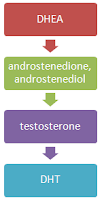 |
| Image 1: It has long been established that diabetics have particularly low DHEA levels (Loviselli. 1994), but what's the chicken and what's the egg here? |
Not younger, but leaner with a minimalist dose of DHEA?
In a 6 week trial, and thus over a more than eight times longer timespan than in the previously mentioned human study on skelatal muscle damage, Koji Sato and his (or her?) colleagues from the Ritsumeikan University, the Senshu University and the University of Tsukuba (all in Japan, as you probably already suspected) investigated the effects a low dose of DHEA (human equivalent: 0.16mg/kg per day => 10-15mg/day) supplementation on the insulin, QUICKI (=quantitative insulin-sensitivity check index) and intramuscular DHEA and DHT (dihydrotestosterone) levels in sedentary or exercised dietary obese male rodents.
 |
| Figure 1: Relative insulin levels, QUICKI, intramuscular DHEA and DHT content in obese male rodents after 6 weeks of DHEA or combined DHEA + exercise (1h, 5days/week) treatment (data adapted from Sato. 2012) |
Exercise increases intramuscular DHEA & DHT...
 |
| Figure 2: Hormonal cascade from DHEA to DHT; all enzymatic conversions can take place on a systemic and intra-cellular level!) |
Oral DHEA + exercise = double-whammy against obesity
The combined treatment, or I should say the exogenous support of the exercise induced changes had - and this is not visible from the data in figure 1, astonishingly profound effects on the diet induced weight gain of the lab animals. While all other rodents became fatter, those in the exercise + DHEA group remained at a steady body weight level; an observation the researchers comment as follows:
Although DHEA administration and exercise training each produced beneficial effects, 6-weeks of combination treatment were more effective for obesity. The precise mechanisms that reduced abdominal fat weight in the combination group remain unclear, yet we can propose several plausible hypotheses. 2 weeks of DHEA administration has been shown to activate fatty acid metabolism-related enzymes, such as long-chain fatty acyl-coenzyme A synthase, and to increase free CoA levels in liver (Mohan. 1998; Mohan. 1990). In addition, exercise training is known to reduce adipogenesis via upregulation of fatty acid metabolism and increased energy expenditure (Hou. 2003). Therefore, 6-weeks of combination treatment may have promoted additive reductions in abdominal fat volume.
In other words, while DHEA increases the efficacy of fatty acid oxidation, exercise takes care of the increase in energy expenditure which is - all convictions wrt to "calories don't count" and the "calories in vs. calories out"-hypothesis aside - still a fundamental prerequisite that the fatty acids do actually get burned and are not released into circulation to be restored or replaced a couple of hours later.
"Ok, I am just ordering some DHEA, how much should I take?"
Before you head over to the online vendor of your choice to make sure you get your share of DHEA before the FDA hears that it could hamper the sales of diabetes drugs and removes it from the OTC market, I would like to remind you that despite the fact that Sato et al. rightly claim that a "combination treatment [with DHEA and DHT] may be more beneficial than either therapy alone", a cursory glance on the data in figure 1 should suffice to tell you that those additional benefits as statistically significant as they may be are just that "additional" and that exercise alone yielded about equal results, is free of negative and full of beneficial side effects (update: as long as you don't overtrain; thanks Stapedius for this important note) and does not have the same host of studies refuting its efficacy as DHEA has (Clore. 1995).
It is nevertheless intriguing that a hormone the medical orthodoxy has, more or less all of a sudden, dropped like a hot potato and declared "questionable" and "ineffective" is now, roughly 15-20 years being rediscovered... and I am pretty sure that this was not the last DHEA study you will see and read about here at the SuppVersity ;-)
References:
- Clore JN. Dehydroepiandrosterone and body fat. Obes Res. 1995 Nov;3 Suppl 4:613S-616S. Review.
- Hou CW, Chou SW, Ho HY, Lee WC, Lin CH, Kuo CH. Interactive effect of exercise training and growth hormone administration on glucose tolerance and muscle GLUT4 protein expression in rats. J Biomed Sci. 2003 Nov-Dec;10(6 Pt 2):689-96.
- Loviselli A, Pisanu P, Cossu E, Caradonna A, Massa GM, Cirillo R, Balestrieri A. [Low levels of dehydroepiandrosterone sulfate in adult males with insulin-dependent diabetes mellitus]. Minerva Endocrinol. 1994 Sep;19(3):113-9.
- van der Merwe J, Brooks NE, Myburgh KH. Three weeks of creatine monohydrate supplementation affects dihydrotestosterone to testosterone ratio in college-aged rugby players. Clin J Sport Med. 2009 Sep;19(5):399-404.
- Mohan PF, Cleary MP. Effect of short-term DHEA administration on liver metabolism of lean and obese rats. Am J Physiol. 1988 Jul;255(1 Pt 1):E1-8.
- Mohan PF, Ihnen JS, Levin BE, Cleary MP. Effects of dehydroepiandrosterone treatment in rats with diet-induced obesity. J Nutr. 1990 Sep;120(9):1103-14.
- Sato K, Iemitsu M, Aizawa K, Ajisaka R. Testosterone and DHEA activate the glucose metabolism-related signaling pathway in skeletal muscle. Am J Physiol Endocrinol Metab. 2008 May;294(5):E961-8. Epub 2008 Mar 18.
- Sato K, Iemitsu M, Aizawa K, Mesaki N, Ajisaka R, Fujita S. DHEA administration and exercise training improves insulin resistance in obese rats. Nutr Metab (Lond). 2012 May 30;9(1):47. [Epub ahead of print]










0 comments:
Post a Comment